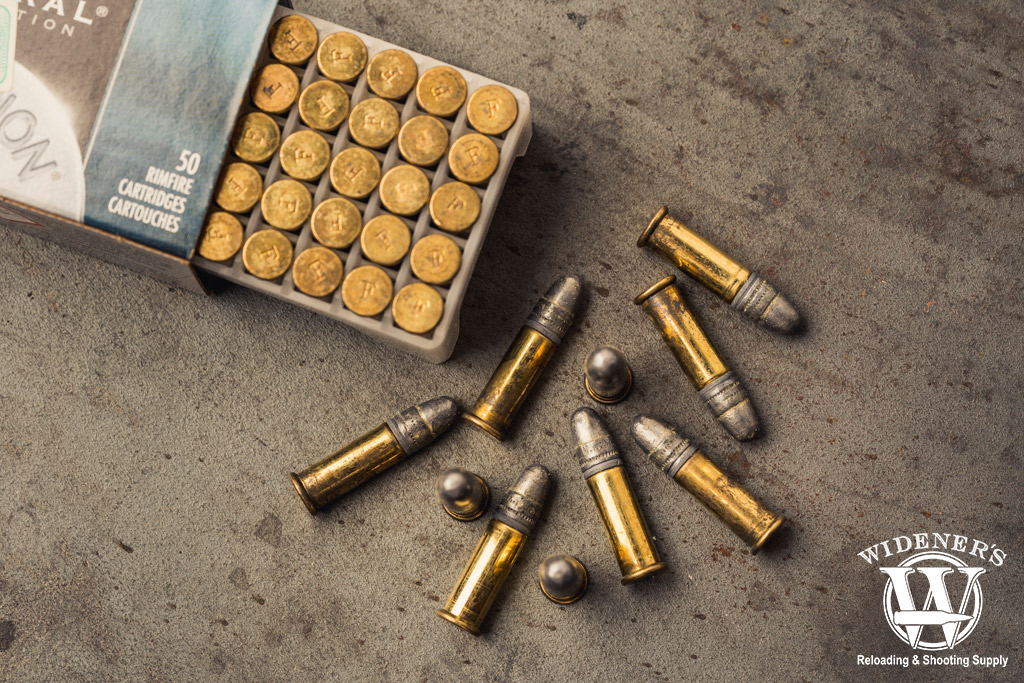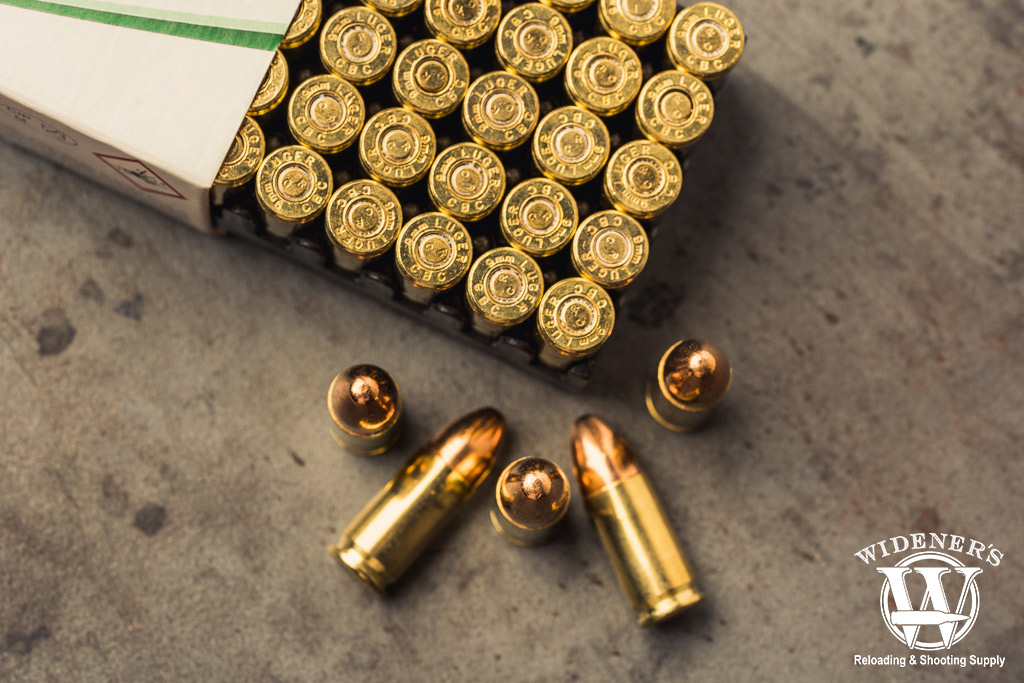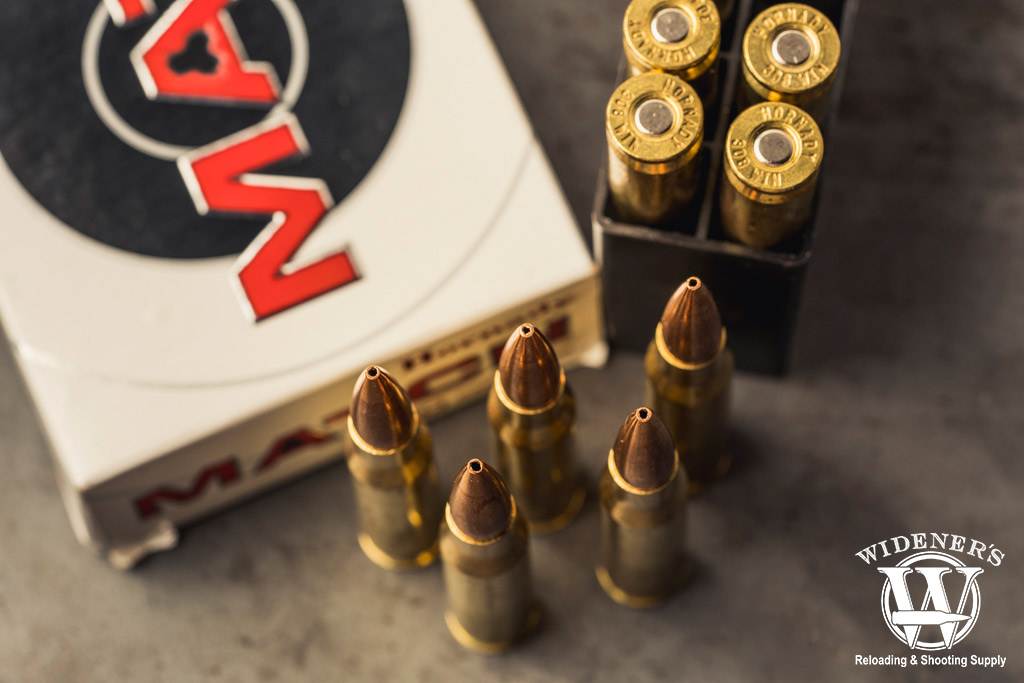

If you’re a new gun owner, you may not yet know the differences between Hollow Point VS FMJ. That’s ok. We’ll cover everything you need to know in the article below. One of the most important things you can do is familiarize yourself with a few different bullet types.
This knowledge will help you save money as you purchase the correct ammunition for your intended purposes. Most importantly, we will ensure that you purchase the correct type of ammunition for self-defense. This could very well spell the difference between life and death if ever forced to draw your firearm.
Before we explain the difference between Hollow Point VS FMJ, let’s start with the most basic type of bullet.
Understanding Bullet Types

The lead round nose (LRN) bullet is still popular with rimfire fans and cowboy action shooting enthusiasts.
Lead Round Nose (LRN)
The earliest bullets made were entirely of solid lead. Lead is an ideal metal for bullets because of two reasons. It is inexpensive and very dense. This enables the bullet to retain the momentum it needs to hug a flat trajectory. It also helps it strike its target with a lot of energy.
A common use for the LRN is in revolvers and certain rifles, such as lever-action. It is fundamentally the same bullet used during the Civil War. Musket balls were commonly used before then. Nowadays, the smooth, round lead projectiles are only used by historic firearm enthusiasts.
Its lack of any copper makes the LRN the most affordable type of projectile. The LRN lacks a hard metal exterior. It is likely to deform as it penetrates soft tissue. This will produce a wider wound channel than the LRN’s original diameter alone could account for. If the bullet is a hollow point (HP) it will be able to expand even wider. But, let’s not get ahead of ourselves.
You can learn a lot more about them in our lead round nose bullet guide here.
Comparing Hollow Point VS FMJ

The full metal jacket (FMJ) features a lead bullet covered in a hard metal or bimetal copper shell.
Full Metal Jacket (FMJ)
With the rise of automatic firearms, there also came a demand for harder bullets. Relatively soft lead bullets, like the LRN can easily get dented and stuck while they are fed into an automatic or semi-automatic firearm’s chamber. This makes the firearm inoperable until it can be manually cleared. This is not something you want to deal with while the other side’s army is shooting at you.
In 1882, a Swiss colonel named Eduard Rubin came up with a clever idea. He covered the lead bullet in harder metal. This idea would save on production costs and retain the density a bullet needs to remain effective. He realized he could still make it mostly out of lead, while simultaneously hardening the bullet for improved functionality in self-loading firearms. Today’s FMJ bullets typically have copper or copper-alloy jackets. Manufacturing of bimetal jackets, predominantly made of steel, commonly take place in Russia.
As an added benefit, the FMJ’s hard metal jacket prevents lead residue from accumulating in a barrel’s rifling. This keeps the firearm more accurate in between cleanings.
Today the FMJ remains the gold standard for target shooting. It is also used by militaries for international warfare. The FMJ is considered more humane. The reasoning being that a non-expanding bullet incapacitates a soldier just as effectively as a deadlier, expanding bullet.
As a civilian, you should typically only use FMJ ammo when you are shooting things that are not alive. It offers ballistic performance comparable to a bullet that is optimized for self-defense. However, its simple design means you will not have to pay extra for unnecessary terminal expansion. Or the years of engineering research that accompany sophisticated projectiles.

The hollow point (HP) is a lead core bullet with an open nose cavity and copper shell.
Hollow Point (HP)
The HP is the basic self-defense bullet. You will also commonly find it on small hunting cartridges, such as the 22 LR.
True to its name, the HP bullet features a hollow point nose cavity. When the HP meets resistance from soft tissue, that resistance will fill its nose cavity. Subsequently forcing the bullet to open up outward. We call this “terminal expansion.”
Terminal expansion serves three important purposes. All of which suit the HP better for self-defense than an FMJ:
- As the HP expands, it transfers more of its energy outward instead of merely forward. This rapid energy dispersal deals more damage to the target.
- As the HP expands, it gouges a wider wound channel into its target. This increases the HP’s chance of striking a vital organ. Not to mention causing more bleeding.
- Because the HP expands, it is more likely to come to a full rest within its target. This helps reduce the chance of over-penetration that could jeopardize an innocent bystander.
In short, if you are buying ammunition for self-defense, make certain its bullet has a hollow point. Albeit, with some exceptions, as not all bullets that are suitable for self-defense have nose cavities. But, if you’re just starting to familiarize yourself with ammo, you can save learning about bullets like the wadcutter, the HoneyBadger, and the ARX for later.
What About Other Bullet Types?

The jacked hollow point (JHP) is regarded as the most effective self-defense round.
Jacketed Hollow Point (JHP)
Remember how the LRN isn’t hard enough to feed reliably in a self-loading firearm? Well, a pure lead HP bullet can jam just as easily in a semi-automatic. That’s why we have the JHP. An expanding bullet developed specifically for semi-auto pistols and rifles.
The JHP’s jacket doesn’t just give it the hardness requisite for smooth feeding. It also strengthens the bullet so it can more reliably penetrate barriers, such as heavy clothing, drywall, and even sheet metal. The JHP’s jacket can additionally promote more uniform and reliable terminal expansion. Especially, if it has symmetrical notches radiating from its tip.
Commit this to memory. If your handgun has a magazine and you would ever fire it in self-defense, then you need ammo with JHP bullets.
Do note that many people, including cops prefer exclusively training with the same ammo they’d use for personal protection. This is because every cartridge offers slightly different recoil, point of aim, and ballistic performance. Also, they wish to become as familiar as possible with their all-important self-defense ammo. It’s a good theory, if not expensive in practice.

The total metal jacket (TMJ) is a lead bullet fully encapsulated in a copper shell.
Total Metal Jacket (TMJ)
The TMJ serves the same exact purpose as the FMJ, which is to say it’s for training and target practice. But the TMJ has something the FMJ hasn’t: a jacket that additionally covers its base. Thus totally encapsulating the bullet.
This prevents hot propellant gases from evaporating the lead in the TMJ’s core during ignition. This keeps the air inside indoor shooting ranges relatively cleaner. Choose TMJ ammo if you’re concerned about your respiratory health or spend a significant amount of time training in indoor ranges.

The boat tail hollow point (BTHP) bullet is a non-expanding lead bullet with a copper shell.
Boat Tail Hollow Point (BTHP)
The BTHP is specifically designed for accuracy and not terminal expansion. It is only found in rifle cartridges. This is because its accuracy-enhancing features would not offer an advantage over the relatively short distances handguns are able to cover. It’s a good example of ammo that serves a dual purpose.
The important thing to know is that it’s a match-grade bullet. Designed for accuracy. The bullet is in the shape of a teardrop. This design gives it a lower drag coefficient, producing less turbulence as it spins.
We won’t dive too deep into how the BTHP works. We do want to emphasize that despite technically having a nose cavity, the BTHP will not expand as it penetrates soft tissue. Though, there are some exceptions, which we’ll cover in another article. Basically, its terminal performance is inadequate for deer hunting. Its most common function is to neutralize bipedal threats by military snipers.


